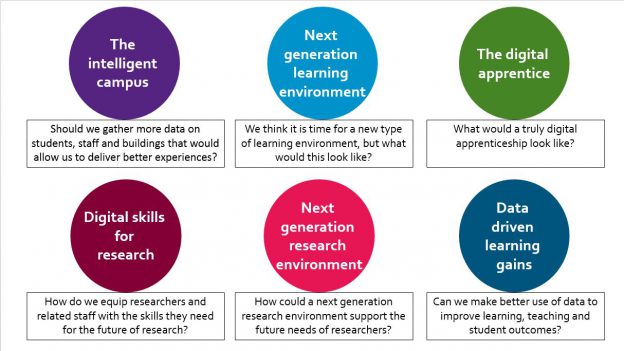Co-design Launch 2016
This week sees the launch of Jisc’s latest co-design challenge (#codesign16), a consultation to find the next set of big ideas for technology in education and research. There are 6 challenges in total, derived from our recently released set of visions, and now we need the help of Jisc members and other experts to identify which of these challenges we should be exploring further.
Research Challenges
We’re pleased to announce that two of the challenges have a research focus and aim to address some of the fundamental issues universities are facing with the advances of technology in research – Digital Skills for Research and Next Generation Research Environments.
This post describes the two provocative research challenges and how you can get involved. In both areas we are aiming to cascade the insights that our recent research at risk and open scholarship activity have given us, to benefit a much wider range of users – to make the use of technology to support research simpler and more closely aligned to research needs.
Digital Skills for Research
Challenge lead: Caroline Ingram
Over many years, Jisc has supported the development of training materials for open access publication and research data management. In revisiting the idea of developing research skills we would be looking much more widely across the training offer for technology-enhanced research, and at a range of roles and levels. How do we equip people with the skills they need for the future of research to ensure the UK keeps its position as a leader in research? Give us your ideas!
The full text of the challenge, where you can post comments, is at Digital Skills for Research.
Next Generation Research Environments
Challenge lead: Christopher Brown
Researchers continue to push the boundaries of research, throughout the research lifecycle, using the latest tools and technologies to support their work. The time has come to define what a next generation research environment should look like and develop a modular solution that can satisfy the increasing demands of researchers. How would you define such a research environment? What functionality should it have to support researchers performing innovative research? Tell us what you think.
The full text of the challenge, where you can post comments, is at Next Generation Research Environments
How to get involved
We encourage you to engage with the discussion around these research challenges and to provide feedback during the consultation phase, which ends on 24 November. There are a number of ways to provide feedback and comment on these challenges:
- Add a comment to this blog post
- Add a comment to the following shared challenge documents:
- Email the following accounts with your ideas and questions:
- Email the challenge leads direct (see above for details)
We will be collating feedback and posting summaries via this blog (at https://researchdata.jiscinvolve.org/wp/category/codesign16/) during the consultation phase.
Finally, follow, and contribute to, the debate on Twitter using the #codesign16 hashtag. Come and join our tweetchat sessions, when we’ll be taking over the @Jisc account to answer your questions, on the following dates:
- Skills for Research – 8 November 11:00-12:00
- Next Generation Research Environments – 16 November 12:30-13:30


One reply on “How would you solve the research challenges of the future?”
Ideas for a future research data environment: Here are some possible data citation solutions and tools – from the Clipper project. During our Research Data Spring project, we undertook some pilot activities (will be published soon!) and gathered quite a lot of rich user requirements. This has fed into a discussion that was sparked off by attending the last RDN event in Cambridge – please see http://blog.clippertube.com/index.php/2016/09/13/clipper-jisc-rdn-workshop-cambridge-6th-september-2016-sparking-ideas/. We think this might have the basis of an idea for an elegant and simple data citation solution – using DOIs, ORCID and the rapidly emerging W3C Web Annotation (W3C WA) standards content that also used DOIs to point to the data and ORCID to identify the data creators and the authors of the citation notes / content. Being web based, using html as the native content format, combined with using these standards seems to have a lot of potential to us. Although arising in the context of annotating / citing audio visual data in the Clipper project we realised that were also citing the data sources we were using to create our annotation using the W3C WA standard data model – by adding DOIs and ORCID this might be the basis for a general purpose data toolkit?. In essence the W3C WA would act as a lightweight container to carry the citation / notes.
John